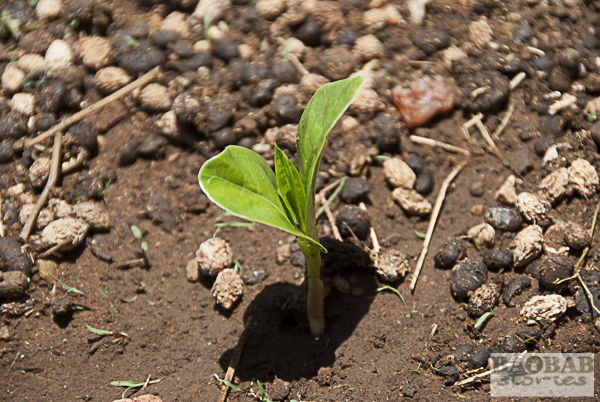We are still in the Venda area of South Africa. Today we visit the Baobab Guardians with Dr. Sarah Venter, baobab ecologist and entrepreneur. The Guardians are women who take care that little baobabs survive in Venda.
Baobab Creates Income
During her research for her doctorate thesis on baobabs in the Venda area, Sarah Venter found facts that led her to found her company “EcoProducts” and the Eco Products Foundation. Part of the foundation is the Baobab Guardians program, which took up its work in 2013.
While doing her research, Venter quickly realized that many Baobab fruit rotted unused on the ground. She started her business and ever since buys Baobab fruit in the Venda for further processing. This has opened up a much needed source of income, especially for the women in the very remote area.
Traditionally, it was the task of women to collect baobab fruit as is still common practice today. Men mostly work in larger cities or mines. The women remain in the villages and are responsible for taking care of children and household chores – which is very difficult without reliable income.
Well-Being of Humans and Trees
Venter does not only see the baobab trees with an entrepreneurial attitute. As a baobab ecologist she has a particular interest in the welfare of baobabs and the environment in general. In her studies she explores how the removal of the fruit affects the propagation of the trees. She has found that despite the collecting activities for export and local consumption enough fruit remain in nature for the trees to reproduce.
Difficult Propagation
Nevertheless, it seems very difficult for the baobabs in the Venda area to reproduce in sufficient numbers – although they produce many fruit, which in turn carry plenty of seeds. However, they need specific conditions for the seeds to germinate at all.
The shells of the seeds are very hard. In Southern Africa people say that they first have to pass through the stomach of an elephant or other mammal. The digestive juices make the shell permeable. The heaps of dung deliver perfect conditions for the seeds to start their journey into life.
However, the seeds need adequate and regular water for rapid growth. Venter believes that the ideal combination of sufficient water, heat and nutrients for baobabs to successfully reproduce only occurs once every 100 to 150 years in the Limpopo Province. The timeframes might even become larger due to climate change.
Hungry Herbivores Endanger Little Baobabs
Even if the litlle baobabs meet ideal starting conditions, their survival is not assured. They are highly sought after by antelopes, goats and cattle. Particularly in densely populated areas like the Venda region seedlings face difficulties. The hungry ruminant preferably nibble off leaves and shoots.
Normally baobabs take between 10 and 25 years until they bear fruit. But in the Venda area it might take up to 200 years. Several factors contribute to this phenomenon, for example the condition of soils and the availability of water. Baobabs are very frugal – but they need a certain level of supply.
A Wise Glimpse into the Future
Taking care of the survival of trees today whose economic benefits can be felt by the people only in many years to come is an enormous challenge – especially if the principle of afforestation is not culturally anchored. Therefore Venter came up with her idea of the Guardians Program where she finances planting and care of Baboabs as well as environmental education for the people of Venda .
Any woman who takes part in the Guardians Program, ensures that a Baobab seed germinates. She waters it regularly and protects it from hungry goats, cattle and chickens. When the Baobab seedling is large enough, she looks for a suitable place on their homestead to plant the tree.
Venter visits the women and trees and supports them in their efforts. She measures the baobab seedlings. For every centimeter a baobab has grown, the guardian gets an allowance so that she continues to take care. It takes a baobab seedling approximately three to five years growth until it can survive on its own.





